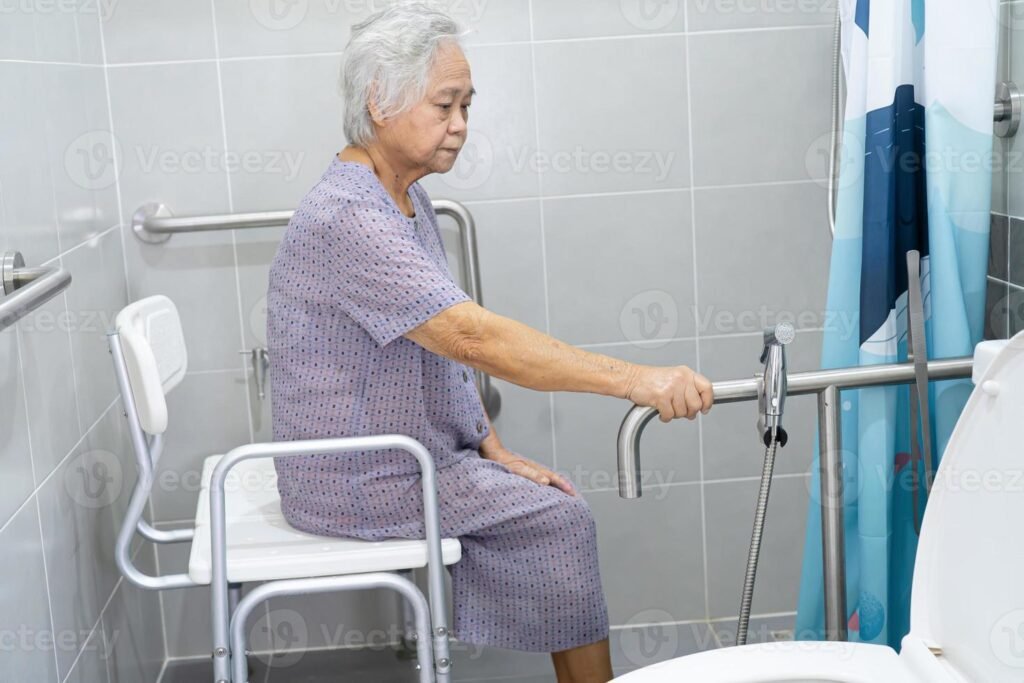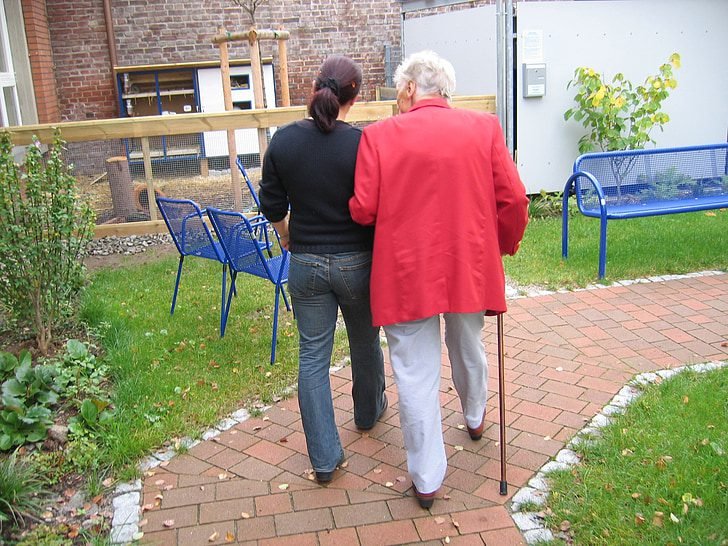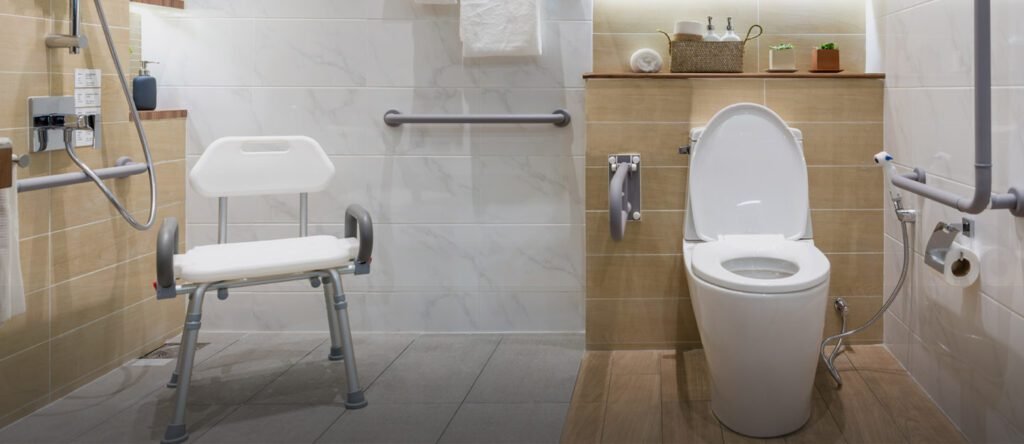Help An Elderly Person With Toileting | Safety Tips & Techniques
As people become older, their effectiveness in performing daily life tasks is significantly reduced. They may begin to rely on their families or caregivers to assist them with ADLs.
Assisting elderly individuals in toileting, can be an emotionally and physically stressful situation. It’s okay to feel uncomfortable helping the elderly with toileting. There are several other options and care facilities to provide them with the care and support they need. This article aims to explore signs one needs assistance with toileting, strategies to help them, and certain equipment your loved one needs in attending to their personal needs.
Also, Read: Dementia Toilet Obsession – What Can You Really Do About It?
Strategies To Help an Elderly Person with Toileting?
Certain steps and strategies can help manage the struggle of coping with elderly individuals who require toilet assistance. It is essential to remain empathetic and patient when dealing with elderly individuals to not embarrass them.


Establish a Routine
Create a consistent and regular toileting schedule and give toilet breaks in between. This sense of routine can help in preventing incontinence.
Encourage Independence
Allow the elderly to perform the tasks independently and only help them when they require assistance. Letting them use the toilet on their own can make them less reliant on other people and promote independence.
Respect their Privacy
Senior individuals may feel hesitant or uncomfortable receiving assistance from others while using the toilet. It is crucial to not invade their space and only help them when they are comfortable with it or allow it. Knock before entering the bathroom and consider their personal space too.
Keep Supplies Handy
Keep necessary supplies such as wipes, toilet paper, or hygiene products close. Having easy access to such items can help elderly people to use the toilet more efficiently.
Comfortable Clothing
It is vital to provide old people with clothing that is easy to remove. Prefer clothing items such as elastic waistbands that are smoother and quicker to remove. Wearing such clothes can help prevent chances of incontinence.


Why Do Seniors Need Bathroom Assistance?
With an increase in age, individuals may encounter several other factors that make them struggle with using the toilet. Some of the factors are given below.
Mobility Issues
Many seniors experience a decline in their ability to move. Certain conditions such as muscle weakness, fatigue, and joint pain can lead to mobility issues in the elderly
Cognitive Impairment
Conditions like Alzheimer’s, likely to happen in old age, lead to the deterioration of the cognitive abilities of an individual. This can make it difficult for aged individuals to recognize their need to use the toilet, consequently, leading to incontinence.
Balance Problems
People in old age usually lose their hold on balance, increasing their chances of falling and injuring themselves. Assistance in the bathroom helps prevent falls or any other accident.
Vision Impairment
Aging usually comes with an impairment in vision. Senior people may not navigate through their surroundings efficiently making it difficult for them to use the toilet.
Side Effects of Medications
Aging is usually accompanied by the use of several medications. Some of the medications may induce dizziness or impair coordination increasing the chances of falls.
Environmental Barriers
Many old people may find it hard to use the toilet due to slippery surfaces and a tight space. Aged people may require external help to move around in the bathroom without falling.
What are the Signs Someone Needs Assistance with Toileting?
It is vital to look out for signs that suggest someone needs help with their daily tasks. Make sure to keep a close eye on the following cues to provide your loved ones with the support they need with toileting.
Incontinence
Increased events of incontinence may suggest that a person requires assistance with managing toiletry needs. This may be urinary incontinence or fecal incontinence.
Frequent Trips to the Bathroom
An increase in the number of visits to the bathroom may suggest that a person is dealing with bladder or bowel issues. It is crucial to find the reason behind these issues and address them accordingly.
Changes in Behavior
If a person expresses signs of frustration or embarrassment when they need to use the toilet. It may be because they are struggling with using it and require help.
Physical Signs of Struggle
Evidence of struggling with mobility or maintaining balance may suggest their inability to use the bathroom on their own.


How Often Should You Toilet a Senior?
An average healthy person can feel the need to urinate 6-7 times a day however, as one age, the muscles in the bladder may weaken over time. This can lead to increased use of toilets in the elderly.
The frequency of toileting in a senior may also depend on several other factors and may vary from individual to individual. Some people may have an overactive bladder while others may feel the need to urinate more because of an underlying issue such as a urinary tract infection.
Taking their health, habits, and fluid intake is essential to recognize their need to use the toilet and help them. If your loved one is experiencing pain or a sudden change in their toileting frequency, it is best to consult a healthcare professional.
How to Assist a Bedridden Person in Toileting?
Assisting a bedridden person in toileting can be overwhelming for families and caregivers. However, if done right with patience and careful planning, it can assist in managing their bathroom needs with effectiveness. The following steps can help carry out the process successfully.
- Gather Supplies: Ensure you have all the necessary supplies with you. Keep disposable gloves, wipes, bedpan, or commode within reach.
- Maintain Privacy: Maintain their privacy by closing the doors or the curtains.
- Position the Bedpan or Portable Commode: Ensure the cleanliness of the bedpan or the portable commode. Position them accurately so the individual can use them with comfort.
- Provide Support: If the person is unable to sit up or maintain balance, offer your support by lifting and positioning.
- Offer Assistance with Cleaning: Help the elderly individual by wiping and cleaning their perineal area. This can help prevent skin itching or infections.
How to Create a Safe Bathroom Environment for the Elderly?
Building a safe bathroom environment is crucial to prevent any accidents and injuries in elderly individuals. It can also enhance their independence in using the restroom when provided with safer circumstances.


Use Grab Bars
Install multiple grab bars in the bathroom. This can help provide elderly individuals with stability and support. Prefer installing them near the bathtub, toilet, or bathroom sink.
Use Non-Slip Mats
Use non-slip mats inside and outside of the bathroom to prevent any falls. These mats can help elderly individuals move without the fear of slipping on wet surfaces.
Provide Adequate Lighting
Install adequate lighting in the bathroom for the elderly individuals to improve visibility. This can assist individuals in using the toilet independently, especially during nighttime.
Use a Raised Toilet Seat
A raised toilet seat can assist the elderly to sit down and get up with ease. It reduces the amount of energy they have to put in while getting up and also prevents the risk of losing balance.
Keep Toilet Paper Close
Ensure the toilet paper is within easy reach while using the toilet. It can help the elderly to access it without losing balance.
Some Essential Toileting Equipment for the Elderly
Certain toileting equipment can make your journey easier in helping an elderly individual with toileting. Following are some of them.
Toilet Safety Frames
Toilet safety frames are helpful in maintaining balance in elderly individuals. These frames are attached to the toilet and provide support for the arms.
Bedside Commodes
People who have difficulty going to the bathroom can use bedside commodes. They have adjustable height settings and provide ease to individuals who struggle with mobility.
Transfer Benches
Transfer benches extend from the outside of the bathtub to the inside. These benches allow individuals to sit on them and then slide into the bathing area. This equipment can help in bathing without having to step over to the other side, preventing the risk of falling.
Toilet Tissue Aids
Toilet tissue aid helps elderly people use toilet paper on their genitals without bending and stretching.
Toilet Lifts
The toilet lifts provide lifting support to people who struggle with getting up from the toilet seat. These toilet seats can be mechanical or electrical.
What are Some Incontinence Supplies for the Elderly?
Incontinence is common in elderly people, what’s important is to not lose your temper and cope with older adults with respect and patience. Certain supplies can help deal with incontinence in the elderly by maintaining cleanliness and preventing skin irritation.
Adult Diapers
The adult diapers can help with absorbent protection from both urinary and fecal incontinence. They come in different sizes and absorbency levels.
Incontinence Bedding
Incontinence bedding protects mattresses from urinary incontinence. These beddings come in different fabrics and sizes.
Belted Undergarments
Belted undergarments, especially designed for adults are pads attached to belts. They provide a secure and adjustable fit for elderly people who struggle with incontinence.
Protective Ointments
Protective ointments are used to create a barrier on the skin and to prevent skin rashes and irritation.
Emotional Aspects to Address when Helping the Elderly with Toileting
Assisting elderly people with toileting is no wonder, a generous thing to do. However, some emotional aspects should be kept in consideration when helping these individuals.
![6 Activities of Daily Living & Need for Long-Term Care [UPDATED]](https://caringhandshomecarefl.com/blog/wp-content/uploads/2023/11/ADLs-and-IADLs-What-Are-They_-1024x683.jpg)
![6 Activities of Daily Living & Need for Long-Term Care [UPDATED]](https://caringhandshomecarefl.com/blog/wp-content/uploads/2023/11/ADLs-and-IADLs-What-Are-They_-1024x683.jpg)
Maintaining Dignity
Families and caregivers should respect the elderly’s dignity. Talk in a respectful tone and consider their need and preferences.
Privacy and Modesty
Ensure their privacy while they use the toilet. Make sure to close the curtains or close the doors.
Establishing Trust
Another important factor to work on is building trust with the elderly. Take their consent before doing anything and offer assistance only when they allow you to.
Being Patient
Stay patient is vital with seniors. Take things at their pace and encourage independence when they try to do things on their own
Empathetic Listener
Be an empathetic listener for older individuals. Provide a safe space for them to share their concerns.
Conclusion
Helping aged people with daily tasks isn’t just about physical assistance but also about providing them with the emotional care and support they require. It is essential to look out for any sign of discomfort or pain in using the toilet in your loved ones to address it in time. Encourage independence by offering them helpful equipment and environment. Make the experience positive by ensuring their dignity, talking to them in a respectful way, and maintaining their well-being.
FAQs
How to make nighttime toileting safer for an elderly person?
Nighttime toileting can be made earlier by using proper lighting, a bedside commode, or installing grab bars to maintain balance and reduce the risk of falls.
How to take care of a stubborn elderly person?
Handle a stubborn elderly person with patience and understanding. Understand their perspectives and involve them in making decisions in order to build trust.
What is the emotional impact of incontinence on elderly individuals?
Incontinence can damage their self-esteem, they may begin to feel embarrassed, frustrated, and aggressive.
How to alleviate anxiety or fear in an elderly person regarding toileting activities?
Alleviate feelings of fear or anxiety by keeping a calm tone, providing reassurance, and building a safe bathroom environment.
How to make bathroom visits easier for people who have mobility issues?
Make bathroom visits easier by using a wheelchair and installing certain equipment such as grab bars, raised toilet seats, or a shower chair.




![What Are The Pros & Cons of Assisted Living? [2024 UPDATED]](https://caringhandshomecarefl.com/blog/wp-content/uploads/2024/01/Assisted-living-care-pros-cons-e1704122253120-768x612.jpg)


